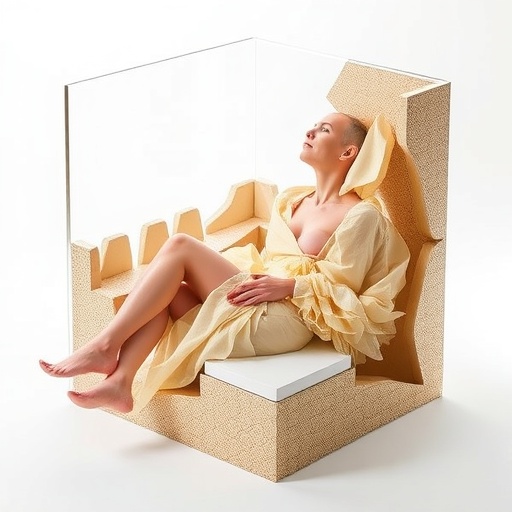In a groundbreaking study, researchers Gulina, Tolstoy, and Murin delve into the intricate world of lead fluoride crystals, specifically focusing on Pb0.8Sr0.2F2 with a fascinating hollow box morphology. The exploration of these crystals sheds light on their evolution under various conditions, including thermal treatment, electron irradiation, and storage. Through their multifaceted approach, the researchers aim to unravel the complexities surrounding the structural transformations that occur within these materials, potentially leading to significant advancements in ion-conducting materials.
The study opens with a comprehensive examination of the crystal structure of Pb0.8Sr0.2F2. The authors paint a vivid picture of its unique hollow box morphology, which has garnered interest due to its potential applications in various technological fields, such as solid-state batteries and other energy storage systems. The significance of this morphology cannot be overstated, as it plays a crucial role in determining the properties of the material, including ionic conductivity and stability under operational conditions.
One of the highlights of this research lies in the investigation of thermal treatment as a means to enhance the properties of Pb0.8Sr0.2F2. Through a series of carefully controlled experiments, the authors expose the crystals to varying temperatures. They meticulously document the effects of these treatments on the structural integrity and ionic conductivity of the crystals, revealing that higher temperatures can often induce favorable changes, setting the stage for better material performance.
Another critical aspect of the study is the impact of electron irradiation on the Pb0.8Sr0.2F2 crystals. The authors detail how exposure to high-energy electrons can lead to significant modifications in the crystal lattice. By employing advanced characterization techniques, they are able to observe the resulting defects and their implications for ionic transport. The insights gained from these experiments underscore the importance of understanding how electron interactions can influence the behavior of these crystals in practical applications.
In addition to thermal treatment and electron irradiation, the study examines the implications of prolonged storage on the structural evolution of Pb0.8Sr0.2F2. The researchers investigate how time-dependent factors can lead to unforeseen changes in the morphology and properties of the crystals. This segment of the research reveals the need for careful consideration of storage conditions in maintaining the integrity and functionality of ion-conducting materials over extended periods.
Throughout their exploration, the authors emphasize the interconnectedness of these various treatments and their cumulative effects on the crystal morphology. The findings suggest that a holistic approach, taking into account thermal, electron, and storage influences, is essential for optimizing the properties of Pb0.8Sr0.2F2 crystals. Such comprehensive analysis lays the groundwork for future research aimed at fine-tuning the synthesis and processing of these materials for enhanced performance.
The implications of this research extend far beyond theoretical interest. With the advancements in energy technologies calling for more efficient materials, understanding the evolution of ion-conducting crystals such as Pb0.8Sr0.2F2 is of paramount importance. As nations strive to achieve carbon neutrality and improve energy storage solutions, the potential applications of these materials could have a substantial impact on the future of energy technologies.
Moreover, the interplay between structure and performance is a central theme in the development of new materials. The fundamental insights gained from this research contribute significantly to the existing body of knowledge regarding ionic crystals, providing a valuable reference point for future explorations in material science. Researchers and engineers alike can draw inspiration from these findings, paving the way for innovations that could revolutionize energy storage and conversion technologies.
As the study concludes, the researchers call for further investigations into the precise mechanisms driving the structural transformations of Pb0.8Sr0.2F2 crystals. The journey to understanding these materials is far from over. Future studies could focus on exploring other composition variations and their respective impacts on crystal behavior, ultimately leading to enhanced performance in real-world applications.
In summary, the transformative journey of Pb0.8Sr0.2F2 crystals reveals a great deal about the nature of ion-conducting materials. The study conducted by Gulina, Tolstoy, and Murin not only highlights the profound effects of thermal treatment, electron irradiation, and storage on crystal morphology but also opens up avenues for future research. As we stand on the precipice of a new era in energy technologies, the lessons learned from this research could significantly shape the future landscape of materials capable of meeting our energy demands.
Indeed, the implications are clear: understanding the behavior and evolution of materials at the atomic level will play a crucial role in the advancement of energy solutions. As research in this field progresses, we can only anticipate the potential breakthroughs that will emerge from continued exploration of crystal engineering and its applications in real-world energy systems.
Subject of Research: Evolution of Pb0.8Sr0.2F2 crystals with hollow box morphology.
Article Title: Evolution of Pb0.8Sr0.2F2 crystals with hollow box morphology at thermal treatment, electron irradiation, and storage.
Article References: Gulina, L.B., Tolstoy, V.P. & Murin, I.V. Evolution of Pb0.8Sr0.2F2 crystals with hollow box morphology at thermal treatment, electron irradiation, and storage. Ionics (2025). https://doi.org/10.1007/s11581-025-06670-x
Image Credits: AI Generated
DOI: https://doi.org/10.1007/s11581-025-06670-x
Keywords: Pb0.8Sr0.2F2, hollow box morphology, thermal treatment, electron irradiation, ionic conductivity, energy storage.
Tags: advanced energy storage technologiesadvancements in ion-conducting materialscomprehensive study of crystalline structurescrystal structure analysis techniqueselectron irradiation impact on materialsionic conductivity in energy materialslead fluoride crystalsmaterial stability under operational conditionsPb0.8Sr0.2F2 hollow box morphologysolid-state battery applicationsstructural transformations in lead fluoridethermal treatment effects on crystals





